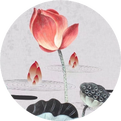The liver is a very important organ in our body responsible for detoxification. If people often experience anger and depression, it can harm the liver. This leads to a condition known as gan yu qi zhi (liver qi stagnation), which is a term used in Traditional Chinese Medicine (TCM). Today, we will explore what liver qi stagnation is and what symptoms it presents.Liver qi stagnation mainly refers to the abnormal function of the liver’s ability to regulate and disperse qi, leading to a state of qi stagnation.In TCM, it is believed that “the liver is a strong organ that prefers smoothness and dislikes depression; in emotions, it is associated with anger.” This means that the liver is a strong and impatient organ that enjoys calm and gentle emotions, and dislikes anger and depression.How to Determine Liver Qi Stagnation In TCM, it is said that all diseases arise from qi. Therefore, only by resolving the issue of liver qi stagnation can women reduce their illnesses or even avoid them altogether.1. Causes of Liver Qi StagnationThe following are some common causes of liver qi stagnation:Family Disharmony: Frequent arguments between spouses or tense relationships with in-laws can lead to liver qi not being smooth.Social Pressure: For example, older unmarried women often face pressure from parents, relatives, and colleagues regarding marriage, along with societal criticism, which can create significant stress and lead to liver qi stagnation.Work Pressure: In modern workplaces, there is no gender preference; women face unprecedented pressure, especially white-collar women who are pulled between family and career, leading to widespread liver qi stagnation.Poor Self-Regulation: Many women struggle to cope with issues, tend to dwell on negative aspects of life and work, and cannot self-soothe, which often results in liver qi stagnation.
In TCM, it is said that all diseases arise from qi. Therefore, only by resolving the issue of liver qi stagnation can women reduce their illnesses or even avoid them altogether.1. Causes of Liver Qi StagnationThe following are some common causes of liver qi stagnation:Family Disharmony: Frequent arguments between spouses or tense relationships with in-laws can lead to liver qi not being smooth.Social Pressure: For example, older unmarried women often face pressure from parents, relatives, and colleagues regarding marriage, along with societal criticism, which can create significant stress and lead to liver qi stagnation.Work Pressure: In modern workplaces, there is no gender preference; women face unprecedented pressure, especially white-collar women who are pulled between family and career, leading to widespread liver qi stagnation.Poor Self-Regulation: Many women struggle to cope with issues, tend to dwell on negative aspects of life and work, and cannot self-soothe, which often results in liver qi stagnation. 2. Symptoms of Liver Qi StagnationOne manifestation is qi stagnation, which means that qi is blocked within the body, leading to feelings of depression and oppression, commonly described as feeling “stifled” or “angry inside.” This is a typical sign of liver qi stagnation. Prolonged liver qi stagnation can lead to heat accumulation, resulting in excessive liver fire and irritability. Some people may sigh frequently, feel unhappy, and easily develop serious illnesses due to self-repression; others may become impulsive and easily lose their temper, causing distress to themselves and others.Many women report that they are aware of their poor health and want to take blood-nourishing supplements, but they often develop mouth ulcers or have trouble sleeping after taking them. Some believe this is due to “deficiency not accepting nourishment,” but in fact, these issues are mostly caused by liver fire; if the liver fire is blocked, how can nourishment be absorbed?The harm caused by liver qi stagnation is significant and beyond imagination; it can lead to blood stasis, weak temper, dampness accumulation, and even yin deficiency with yang excess… In short, the “crimes” of liver qi stagnation are numerous.Currently, there are many people suffering from liver qi stagnation, especially women who juggle family responsibilities and careers, raising and educating children while also caring for elderly parents, making it difficult to avoid liver qi stagnation.How to Determine if You Have Liver Qi StagnationTo diagnose, one must look for evidence, and self-diagnosis is no different. The most critical evidence for liver qi stagnation can be found on the tongue. Generally, a normal tongue is oval-shaped, while a person with liver qi stagnation has a pointed tongue, with the tip and sides appearing red—this is a key clue for liver qi stagnation.Of course, to confirm liver qi stagnation, you will need the following “evidence”:Bitter Mouth: Especially in the morning, many women feel a bitter taste in their mouths.Dry Throat:Feeling dryness in the mouth and throat, as if there is no saliva, although some may still see saliva on the tongue.Feeling of a Lump in the Throat:Always feeling as if there is a lump in the throat that cannot be swallowed or coughed up, known as “plum pit qi.”Dizziness: Some women frequently experience dizziness, either all day or in sudden episodes, and some may also have headaches.Poor Appetite: “Liver wood counteracts spleen earth,” so liver qi stagnation can lead to various spleen and stomach issues, such as lack of appetite, bloating, and stomach pain.Body Temperature Fluctuations: Feeling hot when dressed and cold when undressed, feeling hot in a warm room and cold when going outside.Irritability: People with liver qi stagnation often feel irritable and easily angered.Nausea: Due to “liver wood counteracting spleen earth,” leading to upward stomach qi, causing belching, acid reflux, or even vomiting.Chest Tightness: Feeling tightness in the chest, even palpitations, and being diagnosed with heart problems. In fact, those with heart issues should first address liver qi stagnation, which can help resolve heart problems.Rib Pain: A constant feeling of pain in the ribs.Insomnia with Vivid Dreams: Insomnia can be caused by two main reasons: blood deficiency and liver qi stagnation. Vivid dreams are also a manifestation of liver qi stagnation; such individuals often dream continuously upon falling asleep.Low Mood: Sighing, feeling melancholic, and being overly sensitive.Cold Hands and Feet: Many know that cold hands and feet can be due to yang deficiency, blood deficiency, and blood stasis, but few understand that liver qi stagnation can also cause cold extremities. If cold hands and feet are present along with the above symptoms, consider the possibility of liver qi stagnation.All of the above are criteria for diagnosing liver qi stagnation. If at least one or two symptoms match, and the tongue is pointed, it can generally be determined as liver qi stagnation. In fact, even without looking at these symptoms, women can be aware of their emotional state, any distressing events, who has upset them, whether they feel pent-up, and how significant their work stress is… These matters are clearer to them than anyone else, so the true diagnostic standard for liver qi stagnation lies within themselves.Four Chinese Patent Medicines to Improve Liver Qi Stagnation
2. Symptoms of Liver Qi StagnationOne manifestation is qi stagnation, which means that qi is blocked within the body, leading to feelings of depression and oppression, commonly described as feeling “stifled” or “angry inside.” This is a typical sign of liver qi stagnation. Prolonged liver qi stagnation can lead to heat accumulation, resulting in excessive liver fire and irritability. Some people may sigh frequently, feel unhappy, and easily develop serious illnesses due to self-repression; others may become impulsive and easily lose their temper, causing distress to themselves and others.Many women report that they are aware of their poor health and want to take blood-nourishing supplements, but they often develop mouth ulcers or have trouble sleeping after taking them. Some believe this is due to “deficiency not accepting nourishment,” but in fact, these issues are mostly caused by liver fire; if the liver fire is blocked, how can nourishment be absorbed?The harm caused by liver qi stagnation is significant and beyond imagination; it can lead to blood stasis, weak temper, dampness accumulation, and even yin deficiency with yang excess… In short, the “crimes” of liver qi stagnation are numerous.Currently, there are many people suffering from liver qi stagnation, especially women who juggle family responsibilities and careers, raising and educating children while also caring for elderly parents, making it difficult to avoid liver qi stagnation.How to Determine if You Have Liver Qi StagnationTo diagnose, one must look for evidence, and self-diagnosis is no different. The most critical evidence for liver qi stagnation can be found on the tongue. Generally, a normal tongue is oval-shaped, while a person with liver qi stagnation has a pointed tongue, with the tip and sides appearing red—this is a key clue for liver qi stagnation.Of course, to confirm liver qi stagnation, you will need the following “evidence”:Bitter Mouth: Especially in the morning, many women feel a bitter taste in their mouths.Dry Throat:Feeling dryness in the mouth and throat, as if there is no saliva, although some may still see saliva on the tongue.Feeling of a Lump in the Throat:Always feeling as if there is a lump in the throat that cannot be swallowed or coughed up, known as “plum pit qi.”Dizziness: Some women frequently experience dizziness, either all day or in sudden episodes, and some may also have headaches.Poor Appetite: “Liver wood counteracts spleen earth,” so liver qi stagnation can lead to various spleen and stomach issues, such as lack of appetite, bloating, and stomach pain.Body Temperature Fluctuations: Feeling hot when dressed and cold when undressed, feeling hot in a warm room and cold when going outside.Irritability: People with liver qi stagnation often feel irritable and easily angered.Nausea: Due to “liver wood counteracting spleen earth,” leading to upward stomach qi, causing belching, acid reflux, or even vomiting.Chest Tightness: Feeling tightness in the chest, even palpitations, and being diagnosed with heart problems. In fact, those with heart issues should first address liver qi stagnation, which can help resolve heart problems.Rib Pain: A constant feeling of pain in the ribs.Insomnia with Vivid Dreams: Insomnia can be caused by two main reasons: blood deficiency and liver qi stagnation. Vivid dreams are also a manifestation of liver qi stagnation; such individuals often dream continuously upon falling asleep.Low Mood: Sighing, feeling melancholic, and being overly sensitive.Cold Hands and Feet: Many know that cold hands and feet can be due to yang deficiency, blood deficiency, and blood stasis, but few understand that liver qi stagnation can also cause cold extremities. If cold hands and feet are present along with the above symptoms, consider the possibility of liver qi stagnation.All of the above are criteria for diagnosing liver qi stagnation. If at least one or two symptoms match, and the tongue is pointed, it can generally be determined as liver qi stagnation. In fact, even without looking at these symptoms, women can be aware of their emotional state, any distressing events, who has upset them, whether they feel pent-up, and how significant their work stress is… These matters are clearer to them than anyone else, so the true diagnostic standard for liver qi stagnation lies within themselves.Four Chinese Patent Medicines to Improve Liver Qi Stagnation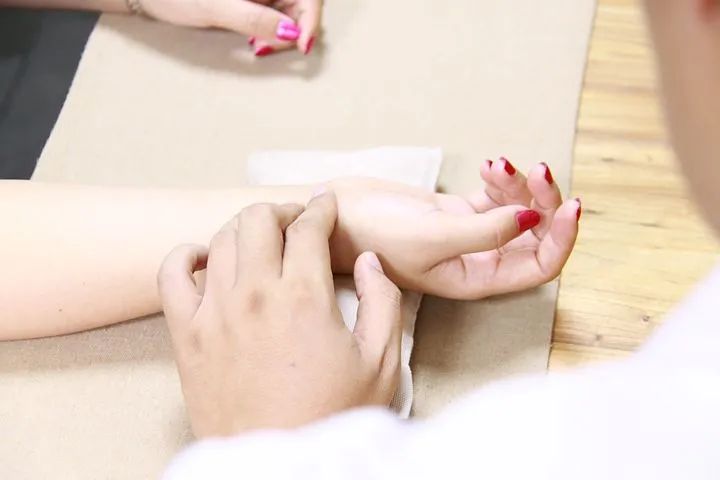 Women with liver qi stagnation should undergo TCM diagnosis and take herbal medicine for adjustment. Here are some recommended Chinese patent medicines.1. Xiao Yao WanThe main ingredients are Chai Hu (Bupleurum), Bai Shao (White Peony), Bo He (Mint), Dang Gui (Angelica), Chao Bai Zhu (Fried Atractylodes), Zhi Gan Cao (Honey-fried Licorice), Fu Ling (Poria), and Sheng Jiang (Fresh Ginger). Among these, Chai Hu and Bo He have qi-regulating effects, while Dang Gui and Bai Shao nourish blood and regulate menstruation.This patent medicine has the effects of soothing the liver, strengthening the spleen, and regulating menstruation, and can treat breast swelling, lack of appetite, discomfort, and irregular menstruation caused by liver qi stagnation and spleen deficiency.2. Shu Gan WanThis patent medicine is very effective for treating liver qi stagnation, mainly composed of Yan Hu Suo (Corydalis), Chuan Lian Zi (Melia), Pian Jiang Huang (Turmeric), Chen Xiang (Agarwood), Mu Xiang (Saussurea), Sha Ren (Amomum), Zhi Qiao (Bitter Orange), Dou Kou Ren (Cardamom), Bai Shao (White Peony), Fu Ling (Poria), Huang Po (Magnolia Bark), Chen Pi (Dried Tangerine Peel), and Zhu Sha (Cinnabar).Main Functions:Soothing the liver and stomach, regulating qi, and relieving pain. It can alleviate stomach pain, chest tightness, and belching caused by liver qi stagnation.
Women with liver qi stagnation should undergo TCM diagnosis and take herbal medicine for adjustment. Here are some recommended Chinese patent medicines.1. Xiao Yao WanThe main ingredients are Chai Hu (Bupleurum), Bai Shao (White Peony), Bo He (Mint), Dang Gui (Angelica), Chao Bai Zhu (Fried Atractylodes), Zhi Gan Cao (Honey-fried Licorice), Fu Ling (Poria), and Sheng Jiang (Fresh Ginger). Among these, Chai Hu and Bo He have qi-regulating effects, while Dang Gui and Bai Shao nourish blood and regulate menstruation.This patent medicine has the effects of soothing the liver, strengthening the spleen, and regulating menstruation, and can treat breast swelling, lack of appetite, discomfort, and irregular menstruation caused by liver qi stagnation and spleen deficiency.2. Shu Gan WanThis patent medicine is very effective for treating liver qi stagnation, mainly composed of Yan Hu Suo (Corydalis), Chuan Lian Zi (Melia), Pian Jiang Huang (Turmeric), Chen Xiang (Agarwood), Mu Xiang (Saussurea), Sha Ren (Amomum), Zhi Qiao (Bitter Orange), Dou Kou Ren (Cardamom), Bai Shao (White Peony), Fu Ling (Poria), Huang Po (Magnolia Bark), Chen Pi (Dried Tangerine Peel), and Zhu Sha (Cinnabar).Main Functions:Soothing the liver and stomach, regulating qi, and relieving pain. It can alleviate stomach pain, chest tightness, and belching caused by liver qi stagnation. 3. Chai Hu Shu Gan WanThe main ingredients include Xiang Fu (Cyperus), Chai Hu (Bupleurum), Zhi Qiao (Bitter Orange, fried), Chuan Xiong (Ligusticum), Bai Shao (White Peony), Chen Pi (Dried Tangerine Peel, vinegar-fried), and Gan Cao (Licorice, fried). This medicine has the effects of soothing the liver, regulating qi, invigorating blood, and relieving pain, suitable for patients with liver qi stagnation who experience chest and rib pain, irritability, and restlessness.4. Dan Zhi Xiao Yao Wan This patent medicine is based on Xiao Yao Wan with the addition of Mu Dan Pi (Moutan Root) and Zhi Zi (Gardenia) to clear liver fire, regulate menstruation, and soothe the liver. It is suitable for women with liver qi stagnation transforming into fire, experiencing irritability, chest and rib pain, dry mouth, flushed face, lack of appetite, tidal fever, early menstruation, menstrual irregularities, and breast swelling.In addition to using medication, dietary adjustments are also a good choice for treating liver qi stagnation. When cooking, consider adding some herbs that help regulate liver qi, such as Dang Shen (Codonopsis), Shan Zha (Hawthorn), Da Zao (Jujube), Fo Shou (Buddha’s Hand), Huang Qi (Astragalus), and Gou Qi Zi (Goji Berries).Additionally, vegetables and fruits like celery, bananas, radishes, and citrus can help clear liver fire and cool the blood, and should be consumed regularly.Cupping and Moxibustion for Regulating Liver Qi Stagnation
3. Chai Hu Shu Gan WanThe main ingredients include Xiang Fu (Cyperus), Chai Hu (Bupleurum), Zhi Qiao (Bitter Orange, fried), Chuan Xiong (Ligusticum), Bai Shao (White Peony), Chen Pi (Dried Tangerine Peel, vinegar-fried), and Gan Cao (Licorice, fried). This medicine has the effects of soothing the liver, regulating qi, invigorating blood, and relieving pain, suitable for patients with liver qi stagnation who experience chest and rib pain, irritability, and restlessness.4. Dan Zhi Xiao Yao Wan This patent medicine is based on Xiao Yao Wan with the addition of Mu Dan Pi (Moutan Root) and Zhi Zi (Gardenia) to clear liver fire, regulate menstruation, and soothe the liver. It is suitable for women with liver qi stagnation transforming into fire, experiencing irritability, chest and rib pain, dry mouth, flushed face, lack of appetite, tidal fever, early menstruation, menstrual irregularities, and breast swelling.In addition to using medication, dietary adjustments are also a good choice for treating liver qi stagnation. When cooking, consider adding some herbs that help regulate liver qi, such as Dang Shen (Codonopsis), Shan Zha (Hawthorn), Da Zao (Jujube), Fo Shou (Buddha’s Hand), Huang Qi (Astragalus), and Gou Qi Zi (Goji Berries).Additionally, vegetables and fruits like celery, bananas, radishes, and citrus can help clear liver fire and cool the blood, and should be consumed regularly.Cupping and Moxibustion for Regulating Liver Qi Stagnation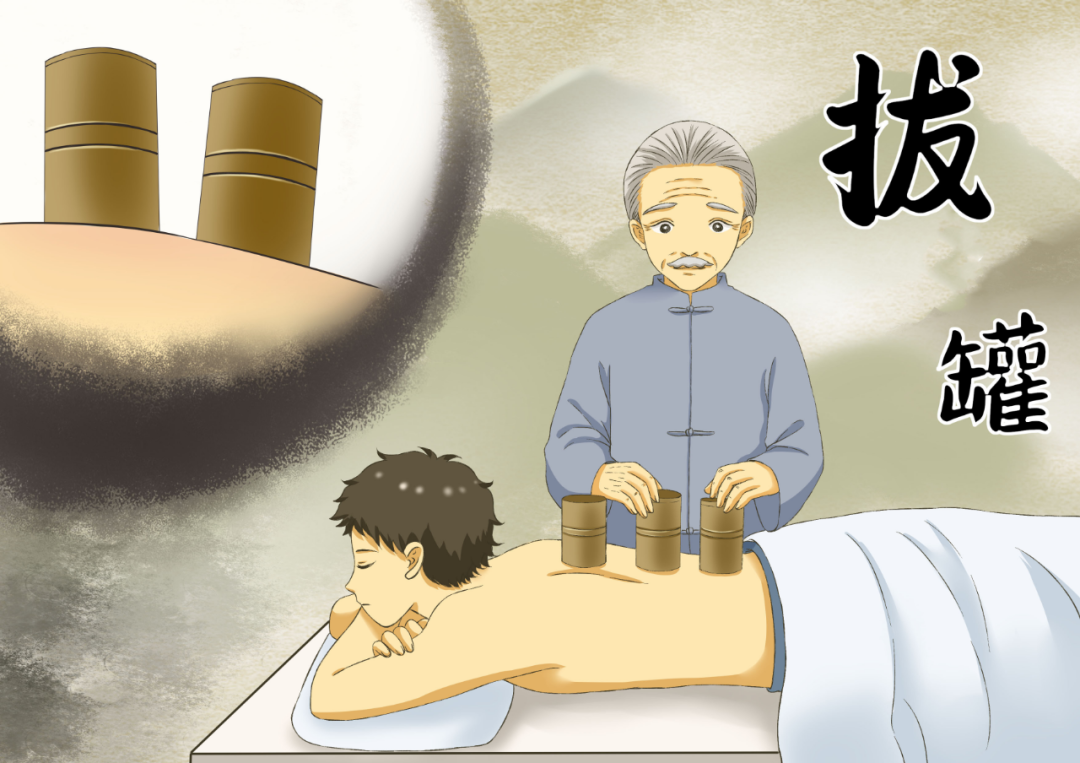 To regulate liver qi stagnation, moxibustion combined with cupping is very effective. The specific acupoints for moxibustion and cupping are as follows:
To regulate liver qi stagnation, moxibustion combined with cupping is very effective. The specific acupoints for moxibustion and cupping are as follows: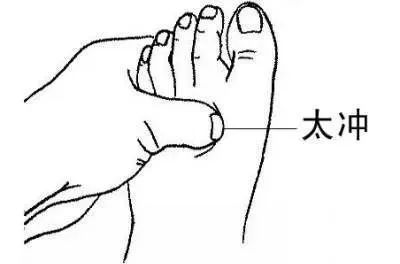 1. Tai Chong (Taichong) Point This point is located on the liver meridian on the dorsum of the foot, in the depression before the junction of the metatarsal bones. Cupping followed by moxibustion at this point can help regulate qi, soothe the liver, invigorate blood, and promote smooth qi and blood flow.
1. Tai Chong (Taichong) Point This point is located on the liver meridian on the dorsum of the foot, in the depression before the junction of the metatarsal bones. Cupping followed by moxibustion at this point can help regulate qi, soothe the liver, invigorate blood, and promote smooth qi and blood flow.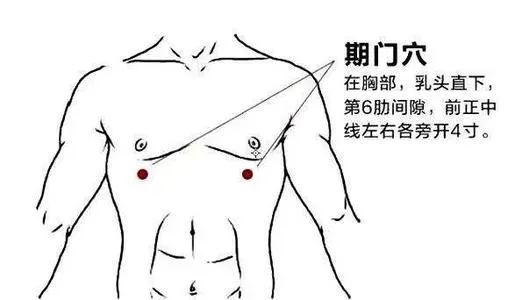 2. Qi Men (Qimen) Point This is the front-mu point of the liver meridian, located in the sixth intercostal space, four inches lateral to the midline (directly below the nipple). Moxibustion at this point can help soothe the liver, strengthen the spleen, regulate qi, and invigorate blood. Cupping can also be combined with Gan Shu (Liver Shu) and Ge Shu (Diaphragm Shu) for additional effects of soothing the liver, invigorating blood, and resolving stasis, primarily treating chest and rib pain. Rubbing the sides of the ribs with both hands can also help soothe the liver and relieve stagnation.
2. Qi Men (Qimen) Point This is the front-mu point of the liver meridian, located in the sixth intercostal space, four inches lateral to the midline (directly below the nipple). Moxibustion at this point can help soothe the liver, strengthen the spleen, regulate qi, and invigorate blood. Cupping can also be combined with Gan Shu (Liver Shu) and Ge Shu (Diaphragm Shu) for additional effects of soothing the liver, invigorating blood, and resolving stasis, primarily treating chest and rib pain. Rubbing the sides of the ribs with both hands can also help soothe the liver and relieve stagnation.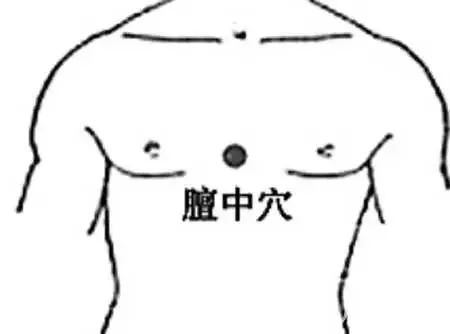 3. Shan Zhong (Shanzhong) Point Located at the center of the chest, between the fourth intercostal spaces (between the nipples). Cupping at this point can invigorate blood circulation, open the chest, regulate qi, and relieve cough and asthma. Even massaging this point can have good effects, alleviating chest tightness, cough, and vomiting. When cupping at these points, if there is no significant discomfort, leave the cups on for 5-10 minutes.Generally, a course of treatment consists of 10 sessions, with cupping done every 5 days, and moxibustion can be done every other day. The color of the cupping marks reflects each person’s constitution and health status:Dark purple marks indicate internal blood stasis;Dark red marks indicate internal heat and more severe conditions;Pale and slightly swollen marks with moisture indicate spleen yang deficiency leading to yang deficiency and water retention;Marks with clear surface patterns and enlarged pores indicate wind and dampness invasion.During cupping, one may feel local tightness, coolness, or swelling; if there is no significant discomfort, the cupping marks will naturally fade within 3 to 5 days without special treatment.
3. Shan Zhong (Shanzhong) Point Located at the center of the chest, between the fourth intercostal spaces (between the nipples). Cupping at this point can invigorate blood circulation, open the chest, regulate qi, and relieve cough and asthma. Even massaging this point can have good effects, alleviating chest tightness, cough, and vomiting. When cupping at these points, if there is no significant discomfort, leave the cups on for 5-10 minutes.Generally, a course of treatment consists of 10 sessions, with cupping done every 5 days, and moxibustion can be done every other day. The color of the cupping marks reflects each person’s constitution and health status:Dark purple marks indicate internal blood stasis;Dark red marks indicate internal heat and more severe conditions;Pale and slightly swollen marks with moisture indicate spleen yang deficiency leading to yang deficiency and water retention;Marks with clear surface patterns and enlarged pores indicate wind and dampness invasion.During cupping, one may feel local tightness, coolness, or swelling; if there is no significant discomfort, the cupping marks will naturally fade within 3 to 5 days without special treatment.
Liver Qi Stagnation is the Source of Many Illnesses, and Many Illnesses Can Be Treated from the Liver
The Relationship Between the Liver and Diseases
The liver is a very important organ, and many diseases can be reflected through discomfort in the liver. There is a saying: “All diseases can be treated from the liver.”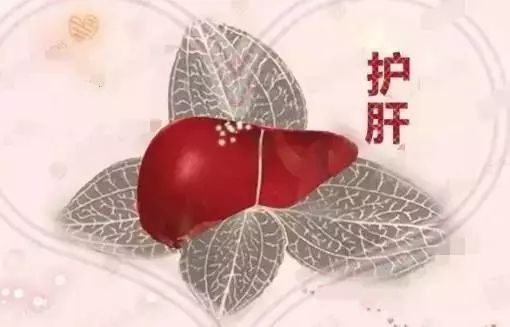 1. Eye DiseasesThe liver opens to the eyes; prolonged viewing can damage blood and, over time, harm the liver.The liver meridian connects to the eyes, and the eyesight relies on the smooth flow of liver qi and the nourishment of liver blood. The Huang Di Nei Jing states: “The liver receives blood and can see”; “Liver qi connects to the eyes; when the liver is harmonious, the eyes can distinguish colors.” If liver blood is insufficient, it can lead to blurred vision and night blindness; if liver yin is deficient, it can cause dryness and reduced vision; if liver fire is excessive, it can lead to red, swollen, and painful eyes.
1. Eye DiseasesThe liver opens to the eyes; prolonged viewing can damage blood and, over time, harm the liver.The liver meridian connects to the eyes, and the eyesight relies on the smooth flow of liver qi and the nourishment of liver blood. The Huang Di Nei Jing states: “The liver receives blood and can see”; “Liver qi connects to the eyes; when the liver is harmonious, the eyes can distinguish colors.” If liver blood is insufficient, it can lead to blurred vision and night blindness; if liver yin is deficient, it can cause dryness and reduced vision; if liver fire is excessive, it can lead to red, swollen, and painful eyes. Clinically, various methods such as soothing the liver and regulating qi, nourishing liver yin, or softening the liver and nourishing blood are often used to treat eye diseases.2. Gynecological DiseasesThe liver governs the regulation and storage of blood, and it prefers smoothness and harmony. Therefore, when the liver fails to regulate, it can lead to many gynecological diseases.For example, irregular menstruation; it can also cause dysmenorrhea due to obstruction of the Chong and Ren meridians, leading to poor blood flow; it can even cause amenorrhea, where menstruation stops; and even pelvic inflammatory disease or infertility… These diseases are all related to liver dysfunction.
Clinically, various methods such as soothing the liver and regulating qi, nourishing liver yin, or softening the liver and nourishing blood are often used to treat eye diseases.2. Gynecological DiseasesThe liver governs the regulation and storage of blood, and it prefers smoothness and harmony. Therefore, when the liver fails to regulate, it can lead to many gynecological diseases.For example, irregular menstruation; it can also cause dysmenorrhea due to obstruction of the Chong and Ren meridians, leading to poor blood flow; it can even cause amenorrhea, where menstruation stops; and even pelvic inflammatory disease or infertility… These diseases are all related to liver dysfunction. The Suwen: On Pain states that “all diseases arise from qi,” which refers to emotional injuries affecting the smooth flow of qi and blood. The liver prefers smoothness and dislikes depression, and since women are born with a strong liver, almost all gynecological diseases are related to the liver.3. Breast HyperplasiaWomen’s breast hyperplasia is related to the pathways of the meridians; the liver meridian starts from the foot, runs up the inner thigh, along the sides of the abdomen, to the sides of the chest, and then to the head, reaching the top of the head. Because it is distributed on both sides of the breast, long-term emotional discomfort, or liver qi stagnation, leads to blood stagnation, which can eventually form lumps, resulting in breast hyperplasia.Breast hyperplasia is a common breast condition in women, categorized as “breast lumps,” presenting as round, cord-like, or nodular masses that may be tender, increasing in size and hardness before menstruation, and alleviating after menstruation, closely related to emotional changes.“To treat lumps, first treat the liver; when qi is regulated, the lumps will dissolve on their own.” TCM believes this condition is often caused by emotional injuries, liver qi stagnation, qi and blood stasis, and phlegm-qi obstruction in the breast channels. Therefore, treatment focuses on soothing the liver, relieving stagnation, invigorating blood, and dispersing lumps.Women with this condition should primarily nourish the liver and manage their emotions, avoiding excessive psychological pressure, not being overly tense at work, and maintaining a pleasant mood.
The Suwen: On Pain states that “all diseases arise from qi,” which refers to emotional injuries affecting the smooth flow of qi and blood. The liver prefers smoothness and dislikes depression, and since women are born with a strong liver, almost all gynecological diseases are related to the liver.3. Breast HyperplasiaWomen’s breast hyperplasia is related to the pathways of the meridians; the liver meridian starts from the foot, runs up the inner thigh, along the sides of the abdomen, to the sides of the chest, and then to the head, reaching the top of the head. Because it is distributed on both sides of the breast, long-term emotional discomfort, or liver qi stagnation, leads to blood stagnation, which can eventually form lumps, resulting in breast hyperplasia.Breast hyperplasia is a common breast condition in women, categorized as “breast lumps,” presenting as round, cord-like, or nodular masses that may be tender, increasing in size and hardness before menstruation, and alleviating after menstruation, closely related to emotional changes.“To treat lumps, first treat the liver; when qi is regulated, the lumps will dissolve on their own.” TCM believes this condition is often caused by emotional injuries, liver qi stagnation, qi and blood stasis, and phlegm-qi obstruction in the breast channels. Therefore, treatment focuses on soothing the liver, relieving stagnation, invigorating blood, and dispersing lumps.Women with this condition should primarily nourish the liver and manage their emotions, avoiding excessive psychological pressure, not being overly tense at work, and maintaining a pleasant mood. “The best doctor treats the disease before it occurs,” meaning prevention is key. For example, liver qi deficiency is commonly seen in women, leading to breast hyperplasia, uterine fibroids, tension headaches, and chronic stomach issues. These can all arise from liver qi stagnation, highlighting the importance of liver nourishment in preventing these diseases.Liver Qi Stagnation Symptoms1.Insomnia:Characterized by difficulty falling asleep, and even if one does fall asleep, they often have vivid dreams and are easily startled. Poor sleep quality can lead to women experiencing blood deficiency, rough skin, and a dull complexion. Insomnia due to liver qi transforming into fire is often caused by anger harming the liver.2.Stagnation can lead to feelings of oppression and anxiety, often resulting in women experiencing headaches, irritability, emotional fluctuations, anger, chest and rib tightness, abdominal bloating, and endocrine disorders.3.The liver meridian runs along the sides of the body, and poor circulation in the liver meridian may lead to breast hyperplasia, breast nodules, or even breast cancer.4.Liver qi stagnation can hinder the flow of qi, leading to loss of appetite due to slow metabolism, fatigue, laziness, and resulting in obesity and constipation.5.The regularity of menstruation in women is closely related to the liver’s ability to regulate. Liver qi stagnation can lead to shortened menstrual cycles, reduced menstrual flow, intermenstrual bleeding, dizziness during menstruation, and insomnia during menstruation.Methods for Regulation1Massage the Yin Tang, Shan Zhong, and Tai Chong PointsDaily massage the Yin Tang point (the area between the eyebrows), Shan Zhong point (the center of the chest), and Tai Chong point (the depression between the first metatarsal bones) for 200 times each, morning and evening, to achieve good effects in soothing the liver and regulating qi, expelling stagnant qi.
“The best doctor treats the disease before it occurs,” meaning prevention is key. For example, liver qi deficiency is commonly seen in women, leading to breast hyperplasia, uterine fibroids, tension headaches, and chronic stomach issues. These can all arise from liver qi stagnation, highlighting the importance of liver nourishment in preventing these diseases.Liver Qi Stagnation Symptoms1.Insomnia:Characterized by difficulty falling asleep, and even if one does fall asleep, they often have vivid dreams and are easily startled. Poor sleep quality can lead to women experiencing blood deficiency, rough skin, and a dull complexion. Insomnia due to liver qi transforming into fire is often caused by anger harming the liver.2.Stagnation can lead to feelings of oppression and anxiety, often resulting in women experiencing headaches, irritability, emotional fluctuations, anger, chest and rib tightness, abdominal bloating, and endocrine disorders.3.The liver meridian runs along the sides of the body, and poor circulation in the liver meridian may lead to breast hyperplasia, breast nodules, or even breast cancer.4.Liver qi stagnation can hinder the flow of qi, leading to loss of appetite due to slow metabolism, fatigue, laziness, and resulting in obesity and constipation.5.The regularity of menstruation in women is closely related to the liver’s ability to regulate. Liver qi stagnation can lead to shortened menstrual cycles, reduced menstrual flow, intermenstrual bleeding, dizziness during menstruation, and insomnia during menstruation.Methods for Regulation1Massage the Yin Tang, Shan Zhong, and Tai Chong PointsDaily massage the Yin Tang point (the area between the eyebrows), Shan Zhong point (the center of the chest), and Tai Chong point (the depression between the first metatarsal bones) for 200 times each, morning and evening, to achieve good effects in soothing the liver and regulating qi, expelling stagnant qi.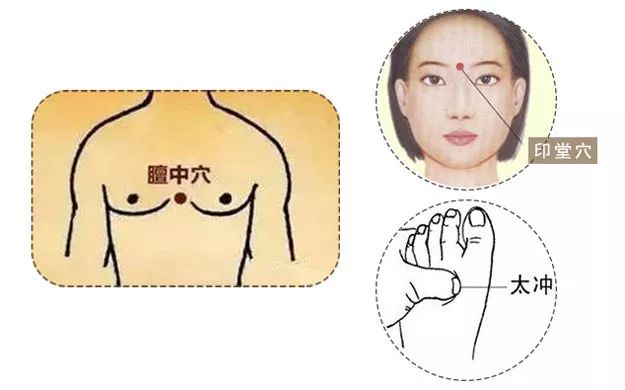 2Tap the Ten FingersFor women with emotional knots, it is recommended to frequently tap the ten fingers, as the fingers are connected to the heart. There are many acupoints on the fingers, and relaxing these points can soothe the heart.In a relaxed state, listen to beautiful music, and rhythmically tap the fingers on the table. Repeating this will gradually untie the emotional knots and lead to forgetting them.3Push the Feet, Liver Meridian, and RibsIn TCM, the liver governs the regulation of qi. When liver qi flows smoothly, all meridians are open. However, liver qi is easily affected by emotions; unhappiness can easily lead to liver qi stagnation. To open the liver meridian, the focus is on pushing.Push the Feet: Start with the left foot, then the right foot, pushing from the top of the foot along the seams towards the toes, applying enough pressure to feel soreness, doing this for fifty times on each foot.Push the Liver Meridian: The liver meridian runs along the inner thigh, at the line of the underwear.
2Tap the Ten FingersFor women with emotional knots, it is recommended to frequently tap the ten fingers, as the fingers are connected to the heart. There are many acupoints on the fingers, and relaxing these points can soothe the heart.In a relaxed state, listen to beautiful music, and rhythmically tap the fingers on the table. Repeating this will gradually untie the emotional knots and lead to forgetting them.3Push the Feet, Liver Meridian, and RibsIn TCM, the liver governs the regulation of qi. When liver qi flows smoothly, all meridians are open. However, liver qi is easily affected by emotions; unhappiness can easily lead to liver qi stagnation. To open the liver meridian, the focus is on pushing.Push the Feet: Start with the left foot, then the right foot, pushing from the top of the foot along the seams towards the toes, applying enough pressure to feel soreness, doing this for fifty times on each foot.Push the Liver Meridian: The liver meridian runs along the inner thigh, at the line of the underwear. When pushing the liver meridian, sit down, bend the left leg, keeping the knee flat, and place both hands on the inner thigh near the groin, applying pressure forward towards the knee, doing this for fifty times on each side until soreness is felt (if there is no soreness, TCM theory states that “where there is flow, there is no pain,” indicating that the liver meridian is open). You can push over clothing or apply some moisturizing medium (such as camellia oil, essential oil, or petroleum jelly) directly for better results.Note:1.It is best not to push the liver meridian after 11 PM.According to the theory of meridian flow, the liver and gallbladder meridians are at rest after 11 PM.2.It is not recommended to push the liver meridian during the later stages of menstruation.According to TCM theory, the liver governs blood storage, and pushing the liver meridian at this time may lead to increased menstrual flow and prolonged menstruation.Push the Ribs:Make fists with both hands, bend the elbows, applying pressure to squeeze the ribs, then perform a motion of straightening and bending the arms, rubbing the ribs until they feel warm.Regulating Daily RoutineIt is crucial to have good daily habits, as quality sleep allows every mechanism in the body to rest and recover effectively.Most self-repair activities in the body occur before 3 AM, so the quality of sleep during the hours of 11 PM to 3 AM is particularly important.Emotional RegulationCultivating a positive emotional state is very important, as a significant portion of liver qi stagnation is caused by negative emotions. Therefore, it is essential to adjust one’s mindset and maintain a pleasant and joyful mood.Dietary RegulationPatients with liver qi stagnation should consume foods that soothe the liver, regulate qi, reduce liver fire, and strengthen the spleen, such as pumpkin, oranges, lentils, sorghum, and coix seeds; foods that reduce liver fire, such as daylily, rapeseed, loofah, and hawthorn; and foods that soothe the liver, such as chrysanthemum, radishes, grapefruit, and tomatoes.What is Liver Qi Stagnation? Many conditions are related to it! Women should pay special attention.1. Definition: Liver qi stagnation, abbreviated as liver depression or liver qi stagnation, is the most common pathological change in liver pathology. It can be caused by emotional stress, depression, or prolonged illness leading to stagnation. Pathological influences from other organs can also affect the liver, leading to loss of regulation and qi stagnation. The mild form is referred to as liver qi not smooth or liver qi stagnation. The pathological characteristics of liver qi stagnation include inhibited liver regulation, leading to qi not flowing smoothly, characterized by emotional depression, rib and flank pain, and a feeling of relief after sighing or belching.2. Pathology: (1) Qi stagnation and blood stasis: Liver qi stagnation leads to qi blockage, which inevitably causes blood flow issues, resulting in blood stasis, manifested as stabbing pain in the ribs, lumps, and a tongue that is purple or has spots. This can affect the Chong and Ren meridians, leading to menstrual irregularities, dysmenorrhea, amenorrhea, or clots in menstrual blood. (2) Phlegm and qi stagnation: Qi stagnation can produce phlegm, which can block the throat, leading to plum pit qi; if it accumulates in the neck, it can lead to goiter. (3) Qi stagnation transforming into fire: Excessive qi can lead to fire; prolonged liver qi stagnation can transform into fire, resulting in upward liver fire. (4) Affecting the spleen and stomach: Liver qi stagnation can lead to qi reversal, affecting the spleen and stomach’s ability to receive and process food, resulting in symptoms such as vomiting, belching, abdominal bloating, and diarrhea. Although liver qi stagnation and liver qi reversal are both conditions of liver qi, their pathological nature is not entirely the same. Liver qi stagnation is due to insufficient liver regulation and qi depression, while liver qi reversal is due to excessive regulation and overactive liver qi. The former is characterized by emotional depression, suspicion, and sadness, while the latter is characterized by impatience and irritability. (Source: 360doc) Attached: What is a goiter? A TCM term referring to lumps that occur in the skin, muscles, or bones. Goiters often occur in the neck, are soft to the touch, and do not rupture; tumors can occur anywhere, are well-defined, and may rupture. Due to different conditions, there are five types of goiters (muscle goiter, blood goiter, flesh goiter, qi goiter, stone goiter) and six types of tumors (muscle tumor, blood tumor, flesh tumor, qi tumor, bone tumor, fat tumor). It specifically refers to goiters. [Ming] Li Shizhen, Compendium of Materia Medica: “Treat water diseases and goiters, with effects similar to seaweed.” [Qing] Dai Ming Shi, “To Zhao Canqi Preface”: “There are many goiter diseases in the mountains and marshes of Qi and Lu, with swollen and bloated appearances.” [Wen Yiduo, “A Daydream”: “But if a certain cell grows too much, exceeding its limits and forming a goiter, etc.” In clinical practice, many TCM practitioners often diagnose patients with “liver qi stagnation” and advise them to make targeted adjustments, including adopting a more open-minded attitude towards life’s challenges, listening to beautiful music, hiking, and walking to relieve stress, among other suggestions. It is evident that in modern society, many people suffer from liver qi stagnation due to emotional factors, affecting their health and even leading to diseases. Women, in particular, are prone to menstrual irregularities and breast issues (breast hyperplasia, benign and malignant tumors), as well as reproductive system diseases (uterine fibroids, endometrial diseases). Neck conditions, such as thyroid goiter, thyroid cancer, and enlarged lymph nodes (lymphoma, benign lymph node hyperplasia), are also related to liver qi stagnation. Writing this reminds me of a colleague and respected female teacher, an expert doctor at a top-tier hospital, who taught us during medical school and guided us during our internships. A few years ago, she was diagnosed with multiple uterine fibroids and atypical endometrial hyperplasia, along with menstrual irregularities, which caused her considerable distress. She firmly believed in Western medicine and was not interested in TCM, deciding to undergo a hysterectomy to eliminate future issues. At that time, I strongly advised her to consider TCM for adjustment, to treat the root cause, as simply removing the uterus was not the best choice. (In fact, a few years earlier, I had little understanding of TCM, but after witnessing my family’s experiences with TCM treatment, I made an effort to learn more about it, and my perspective evolved to a new level.) After TCM treatment, her uterine fibroids improved without the need for surgery, but she did not heed the advice. Now, several years later, I was saddened to hear that she has been diagnosed with breast cancer and has recently undergone surgery. It is truly heartbreaking. I hope she can read this article and realize that with significant work pressure and liver qi stagnation, she must learn to adjust herself. If she had sought TCM treatment earlier to relieve her liver qi stagnation, she might not have reached this point. I remember several TCM practitioners stating that if the liver meridian is problematic, even if the uterus is surgically removed, the disease may still progress to the breast or thyroid, leading to new issues. This is because the underlying imbalances in the body have not been fundamentally resolved, and the pathogenic factors cannot simply disappear by removing a specific organ. (The image below shows the pathway of the liver meridian; reply “meridian map” to this public account to view the pathways of other meridians.) The liver meridian corresponds to the gallbladder meridian, controlling circulation and secretion; a greenish complexion, waist pain, dark circles, and painful menstruation; dry eyes and excessive eye discharge indicate excessive liver fire.· The End · Warm Reminder:All formulas, medicines, and treatment methods mentioned in this article are for the purpose of popularizing TCM knowledge or for learning reference. Non-professionals should not self-medicate! This platform does not bear any responsibility for any consequences arising from this!⊙ Copyright Statement: The article is sourced from the internet; please contact us for removal if there is any infringement.
When pushing the liver meridian, sit down, bend the left leg, keeping the knee flat, and place both hands on the inner thigh near the groin, applying pressure forward towards the knee, doing this for fifty times on each side until soreness is felt (if there is no soreness, TCM theory states that “where there is flow, there is no pain,” indicating that the liver meridian is open). You can push over clothing or apply some moisturizing medium (such as camellia oil, essential oil, or petroleum jelly) directly for better results.Note:1.It is best not to push the liver meridian after 11 PM.According to the theory of meridian flow, the liver and gallbladder meridians are at rest after 11 PM.2.It is not recommended to push the liver meridian during the later stages of menstruation.According to TCM theory, the liver governs blood storage, and pushing the liver meridian at this time may lead to increased menstrual flow and prolonged menstruation.Push the Ribs:Make fists with both hands, bend the elbows, applying pressure to squeeze the ribs, then perform a motion of straightening and bending the arms, rubbing the ribs until they feel warm.Regulating Daily RoutineIt is crucial to have good daily habits, as quality sleep allows every mechanism in the body to rest and recover effectively.Most self-repair activities in the body occur before 3 AM, so the quality of sleep during the hours of 11 PM to 3 AM is particularly important.Emotional RegulationCultivating a positive emotional state is very important, as a significant portion of liver qi stagnation is caused by negative emotions. Therefore, it is essential to adjust one’s mindset and maintain a pleasant and joyful mood.Dietary RegulationPatients with liver qi stagnation should consume foods that soothe the liver, regulate qi, reduce liver fire, and strengthen the spleen, such as pumpkin, oranges, lentils, sorghum, and coix seeds; foods that reduce liver fire, such as daylily, rapeseed, loofah, and hawthorn; and foods that soothe the liver, such as chrysanthemum, radishes, grapefruit, and tomatoes.What is Liver Qi Stagnation? Many conditions are related to it! Women should pay special attention.1. Definition: Liver qi stagnation, abbreviated as liver depression or liver qi stagnation, is the most common pathological change in liver pathology. It can be caused by emotional stress, depression, or prolonged illness leading to stagnation. Pathological influences from other organs can also affect the liver, leading to loss of regulation and qi stagnation. The mild form is referred to as liver qi not smooth or liver qi stagnation. The pathological characteristics of liver qi stagnation include inhibited liver regulation, leading to qi not flowing smoothly, characterized by emotional depression, rib and flank pain, and a feeling of relief after sighing or belching.2. Pathology: (1) Qi stagnation and blood stasis: Liver qi stagnation leads to qi blockage, which inevitably causes blood flow issues, resulting in blood stasis, manifested as stabbing pain in the ribs, lumps, and a tongue that is purple or has spots. This can affect the Chong and Ren meridians, leading to menstrual irregularities, dysmenorrhea, amenorrhea, or clots in menstrual blood. (2) Phlegm and qi stagnation: Qi stagnation can produce phlegm, which can block the throat, leading to plum pit qi; if it accumulates in the neck, it can lead to goiter. (3) Qi stagnation transforming into fire: Excessive qi can lead to fire; prolonged liver qi stagnation can transform into fire, resulting in upward liver fire. (4) Affecting the spleen and stomach: Liver qi stagnation can lead to qi reversal, affecting the spleen and stomach’s ability to receive and process food, resulting in symptoms such as vomiting, belching, abdominal bloating, and diarrhea. Although liver qi stagnation and liver qi reversal are both conditions of liver qi, their pathological nature is not entirely the same. Liver qi stagnation is due to insufficient liver regulation and qi depression, while liver qi reversal is due to excessive regulation and overactive liver qi. The former is characterized by emotional depression, suspicion, and sadness, while the latter is characterized by impatience and irritability. (Source: 360doc) Attached: What is a goiter? A TCM term referring to lumps that occur in the skin, muscles, or bones. Goiters often occur in the neck, are soft to the touch, and do not rupture; tumors can occur anywhere, are well-defined, and may rupture. Due to different conditions, there are five types of goiters (muscle goiter, blood goiter, flesh goiter, qi goiter, stone goiter) and six types of tumors (muscle tumor, blood tumor, flesh tumor, qi tumor, bone tumor, fat tumor). It specifically refers to goiters. [Ming] Li Shizhen, Compendium of Materia Medica: “Treat water diseases and goiters, with effects similar to seaweed.” [Qing] Dai Ming Shi, “To Zhao Canqi Preface”: “There are many goiter diseases in the mountains and marshes of Qi and Lu, with swollen and bloated appearances.” [Wen Yiduo, “A Daydream”: “But if a certain cell grows too much, exceeding its limits and forming a goiter, etc.” In clinical practice, many TCM practitioners often diagnose patients with “liver qi stagnation” and advise them to make targeted adjustments, including adopting a more open-minded attitude towards life’s challenges, listening to beautiful music, hiking, and walking to relieve stress, among other suggestions. It is evident that in modern society, many people suffer from liver qi stagnation due to emotional factors, affecting their health and even leading to diseases. Women, in particular, are prone to menstrual irregularities and breast issues (breast hyperplasia, benign and malignant tumors), as well as reproductive system diseases (uterine fibroids, endometrial diseases). Neck conditions, such as thyroid goiter, thyroid cancer, and enlarged lymph nodes (lymphoma, benign lymph node hyperplasia), are also related to liver qi stagnation. Writing this reminds me of a colleague and respected female teacher, an expert doctor at a top-tier hospital, who taught us during medical school and guided us during our internships. A few years ago, she was diagnosed with multiple uterine fibroids and atypical endometrial hyperplasia, along with menstrual irregularities, which caused her considerable distress. She firmly believed in Western medicine and was not interested in TCM, deciding to undergo a hysterectomy to eliminate future issues. At that time, I strongly advised her to consider TCM for adjustment, to treat the root cause, as simply removing the uterus was not the best choice. (In fact, a few years earlier, I had little understanding of TCM, but after witnessing my family’s experiences with TCM treatment, I made an effort to learn more about it, and my perspective evolved to a new level.) After TCM treatment, her uterine fibroids improved without the need for surgery, but she did not heed the advice. Now, several years later, I was saddened to hear that she has been diagnosed with breast cancer and has recently undergone surgery. It is truly heartbreaking. I hope she can read this article and realize that with significant work pressure and liver qi stagnation, she must learn to adjust herself. If she had sought TCM treatment earlier to relieve her liver qi stagnation, she might not have reached this point. I remember several TCM practitioners stating that if the liver meridian is problematic, even if the uterus is surgically removed, the disease may still progress to the breast or thyroid, leading to new issues. This is because the underlying imbalances in the body have not been fundamentally resolved, and the pathogenic factors cannot simply disappear by removing a specific organ. (The image below shows the pathway of the liver meridian; reply “meridian map” to this public account to view the pathways of other meridians.) The liver meridian corresponds to the gallbladder meridian, controlling circulation and secretion; a greenish complexion, waist pain, dark circles, and painful menstruation; dry eyes and excessive eye discharge indicate excessive liver fire.· The End · Warm Reminder:All formulas, medicines, and treatment methods mentioned in this article are for the purpose of popularizing TCM knowledge or for learning reference. Non-professionals should not self-medicate! This platform does not bear any responsibility for any consequences arising from this!⊙ Copyright Statement: The article is sourced from the internet; please contact us for removal if there is any infringement.

It is incredible that you haven’t clicked “Read More”

